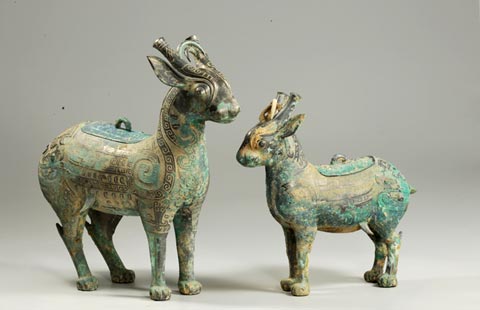Printing firms write new path to profit to counter falling margins
Updated: 2014-04-10 16:03
By Li Wenfang in Guangzhou (China Daily USA)
|
|||||||||
Printing businesses in Guangdong province have been investing in digital printing, one-stop service, industrial parks, electronic applications and environmental certification, to counter shrinking margins.
The profit margin in Guangdong's printing industry, the nation's largest, has been squeezed as an economic slowdown has cut domestic and overseas demand and labor, paper and ink prices rise, said Kong Huanji, executive vice chairman of the Guangdong Printing and Replicating Industrial Association.
National policies are also affecting the industry - for example, a ban imposed last October on the use of public funds for printed gifts, such as calendars and cards. And earlier this month, the government of Guangzhou, capital of Guangdong province, joined other cities in banning excessive packaging of products commonly given as gifts such as moon cakes, tea, liquor and cosmetics.
|
Equipment is on display at an international printing industry exhibition held last month in Guangzhou. The profit margin in Guangdong's printing industry has been squeezed as an economic slowdown cuts domestic and overseas demand and labor, paper and ink prices rise. China News Service |
"There haven't been any bankruptcies in our calendar sub-association, but some of those companies have cut production and some are considering printing other products," Kong said. "We are also against excessive packaging. Reducing the amount of packaging makes design more important, if one is to have both attractive and environmentally friendly packaging." 
Softer demand and growing costs have driven some small printing companies out of business in the past two years, but large ones, defined as those with annual output of more than 20 million yuan ($3.2 million), are stable, although less profitable.
"I heard some only achieved a profit margin of 5 percent last year. Some, a very few, had double-digit margins. Eight years ago, you went into the business, you made a fortune."
As in other parts of the country, the printing industry in Guangdong faces challenges including excess capacity, rising labor costs, falling orders for traditional products and a shortage of skilled workers, said Chau Chi-keung, managing director of Hong Kong-invested C & C Joint Printing Co (Guangdong).
However, Kong said there is still significant room for development of the industry. He noted that the printing industry in Guangdong has managed to expand its output in the past few years.
"When you produce a bottle of mineral water, you need to have the label printed."
The application of digital printing has accelerated in Guangdong in the past six years, a method that provides highly customized copies quickly and generates higher profit margins, Kong said. "An order may be a copy or 100 copies of a photo album, autobiography or memento book." 
Founded in 1992, Guangzhou-based Tianyi Digital Printing Group Co Ltd purchased the first digital press in the country in 2000.
It has 40 branches around the country.
Dongguan-based printing company Hucais Group International Co Ltd jumped on the bandwagon of digital printing in 2011, 23 years after its foundation.
The company plans to build a digital printing town in Dongguan, Guangdong, that will handle all aspects of the business: taking orders, designing products, supplying raw materials and printing, Kong said.
Digital printing makes up only a fraction of the output from the printing industry in the country.
In 2012, 728 digital printing companies in the country generated output of 6.29 billion yuan, up 81.8 percent year-on-year but accounting for only 0.66 percent of the total output from the printing industry, Wang Yanbin, an official with the State Administration of Press, Publication, Radio, Film and Television, told Shanghai International Printing Week in July last year.
Hong Kong-based Luk Ka International Ltd, which has invested in printing facilities in Shenzhen in Guangdong, is building an innovation and cultural park in Shenzhen.
The first phase, which was completed in 2011, includes a printing history museum, Chinese painting gallery, a digital printing center, green printing exhibition, facilities for printing high-quality duplicates of art and display areas for some top international press producers.
liwenfang@chinadaily.com.cn
(China Daily USA 04/08/2014 page13

 Top 10 China archeological discoveries for 2013
Top 10 China archeological discoveries for 2013
 Mummy & me in New Zealand
Mummy & me in New Zealand
 Chinese schools vie in moot court
Chinese schools vie in moot court
 Australian divers start underwater search for MH370
Australian divers start underwater search for MH370
 Cleaver-wielding man subdued after tense standoff
Cleaver-wielding man subdued after tense standoff
 Pro-Russian demonstrators announce Kharkov's independence
Pro-Russian demonstrators announce Kharkov's independence
 Breakdancer 'freezes' in front of Paris landmarks
Breakdancer 'freezes' in front of Paris landmarks
 TV Debate in Boao Forum for Asia Annual Conference
TV Debate in Boao Forum for Asia Annual Conference
Most Viewed
Editor's Picks

|

|

|

|

|

|
Today's Top News
Ships sale to Taiwan 'unlikely'
Hagel gets closer to PLA
21 injured in Pennsylvania school
World leaders join Weibo
Beijing could lead clean-energy debate
China's mixed stories in quest for resources
Crimes of Hirohito on stage: 'We can't let it happen again'
Cross-border deals headed south?
US Weekly

|

|









